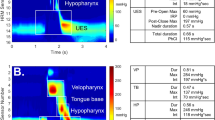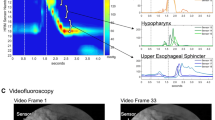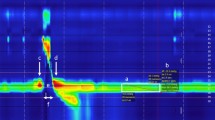Abstract
Acoustic Pharyngometry (APh) is a method for quantifying oropharyngeal tract configuration using sound wave reflection and is commonly used in diagnostics and research of sleep apnea. The standard preset output of APh (minimal cross-sectional area) has been established as reliable. However, by conducting post-processing measures on specific breathing tasks, APh data can also reveal oral length, oral volume, pharyngeal length, and pharyngeal volume. Given that these measures may have utility in dysphagia research, the reliability of these measures is unknown and is the focus of the current study. Ten young healthy female volunteers completed two sessions of APh data collection to obtain measures of oral length, oral volume, pharyngeal length, and pharyngeal volume 1 week apart. Two-way mixed intraclass correlation coefficients were calculated to establish intra-rater reliability, inter-rater reliability, and test–retest reliability. Results revealed excellent levels of agreement within and across raters for all oropharyngeal tract parameters. Levels of test–retest agreement for oral length and oral volume indicated these parameters are appropriate for monitoring change within an individual. All parameters were deemed to have acceptable test–retest values as outcome measures in group-level analysis.


Similar content being viewed by others
References
Marshall I, Maran NJ, Martin S, Jan MA, Rimmington JE, Best JJK, et al. Acoustic reflectometry for airway measurements in man: implementation and validation. Physiol Meas. 1993;14(2):157–69.
D’Urzo AD, Rubinstein I, Lawson VG, Vassal KP, Rebuck AS, Slutsky AS, et al. Comparison of glottic areas measured by acoustic reflections vs. computerized tomography. J Appl Physiol. 1988;64(1):367–70.
D’Urzo AD, Lawson VG, Vassal KP, Rebuck AS, Slutsky AS, Hoffstein V. Airway area by acoustic response measurements and computerized tomography. Am Rev Respir Dis. 1987;135(2):392–5.
Brooks LJ, Castile RG, Glass GM, Griscom NT, Wohl ME, Fredberg JJ. Reproducibility and accuracy of airway area by acoustic reflection. J Appl Physiol Respir Environ Exerc Physiol. 1984;57(3):777–87.
Kamal I. Test-retest validity of acoustic pharyngometry measurements. Otolaryngol Head Neck Surg. 2004;130(2):223–8.
Xue SA, Cheng RWC, Ng LM. Vocal tract dimensional development of adolescents: an acoustic reflection study. Int J Pediatr Otorhinolaryngol. 2010;74(8):907–12.
Xue SA, Hao GJP, Mayo R. Volumetric measurements of vocal tracts for male speakers from different races. Clin Linguist Phon. 2006;20(9):691–702.
Xue SA, Hao GJ. Changes in the human vocal tract due to aging and the acoustic correlates of speech production: a pilot study. J Speech Lang Hear Res. 2003;46(3):689–701.
Vorperian HK, Kurtzweil SL, Fourakis M, Kent RD, Tillman KK, Austin D. Effect of body position on vocal tract acoustics: acoustic pharyngometry and vowel formants. J Acoust Soc Am. 2015;138(2):833–45.
Vorperian HK. VTLab Acoustic Pharyngometry (APh) protocol: data collection (Part I) & data analysis (Part II). 2013. http://www.waisman.wisc.edu/vocal/resources. Accessed 11 May 2016.
Fleiss JL. The design and analysis of clinical experiments. New York: Wiley; 1986.
Fitzpatrick R, Davey C, Buxton M, Jones D. Evaluating patient based outcome measures for use in clinical trial. Health Technol Assess. 1998;2:1–74.
Acknowledgments
I would like to thank Danielle Brates for assistance with data collection and analysis. The research reported in this publication was supported by the National Institute on Deafness and Other Communication Disorders of the National Institutes of Health under award number 1R21DC015067-01, and by the American Speech Language Hearing Association’s Advancing Academic Research Careers Award (ASHA AARC). The content is solely the responsibility of the authors and does not necessarily represent the official views of the National Institutes of Health or ASHA.
Author information
Authors and Affiliations
Corresponding author
Ethics declarations
Conflicts of interest
I have no conflicts of interest to disclose.
Rights and permissions
About this article
Cite this article
Molfenter, S.M. The Reliability of Oral and Pharyngeal Dimensions Captured with Acoustic Pharyngometry. Dysphagia 31, 555–559 (2016). https://doi.org/10.1007/s00455-016-9713-y
Received:
Accepted:
Published:
Issue Date:
DOI: https://doi.org/10.1007/s00455-016-9713-y




